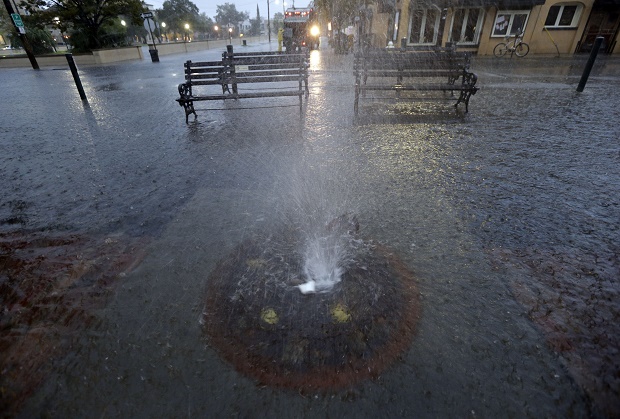
Storm waters squirts from a storm drain in downtown Charleston, S.C., Saturday, Oct. 3, 2015. The National Weather Service says the risk of flooding will continue through Monday morning, especially in parts of North and South Carolina that already have gotten up to 11 inches of rain this week. Forecasters say some areas could see storm totals as high as 15 inches. AP
CHARLESTON, United States — Much of the US southeast was under water Saturday, deluged by rains from Hurricane Joaquin, with forecasters predicting more historic flooding in coming days for the already waterlogged region.
Joaquin, a powerful Category Four storm, brought record-setting rain to many southeastern US states after devastating parts the Bahamas and threatening to do much the same to Bermuda.
News reports have blamed Joaquin for four deaths in the United States since Thursday.
CNN reported that one person was killed by a falling tree in North Carolina. Three others died in weather-related accidents in South Carolina, it said.
Meanwhile, the Bahamas, a low-lying archipelago, has huge areas where homes were destroyed and residents left without power or phone service after the Atlantic storm tore past.
“This is my 26th year living here, and I have never seen this before,” San Salvador resident Paul Turnquest told The Nassau Guardian.
“This is the worst I’ve ever seen.”
The Bahamas’ National Emergency Management Agency was working on damage assessment, and did not immediately have casualty figures.
At least one person was killed on Long Island, Tribune242 reported, as lawmakers headed out on overflights to survey the damage.
And eleven houses were under water on Rum Cay, a resident there told the Guardian. Lawmaker V. Alfred Gray said at least seven homes were totally destroyed between Snug Corner and Mason Bay, on Acklins Island.
The sprawling Bahamas islands is home to 385,000 people and visited by far more tourists every year — about 1.3 million.
US southeast soaked
The US east coast — which had had heavy rains in the days leading up to the arrival of Joaquin — avoided a direct hit, but nevertheless suffered heavy rain from outer bands of the powerful, slow-moving storm.
Some streets in the center of Charleston’s historic old town were submerged.
“We are used to flooding in the area but this is extraordinary,” said police sergeant Edwin Graceley.
John and Merroli Haas, tourists from Kansas, took shelter from the heavy rain under the old market hall. “We were going to go to Savannah today but we decided not to. We didn’t want to take the chance,” she said.
Forecasters said Joaquin now is closing in on tiny Bermuda, population of just 66,000 people, where the potential damage could rival what was seen in the Bahamas.
At 2100 GMT, Joaquin was packing winds of 150 miles per hour (240 kilometers per hour).
The hurricane’s center was some 500 miles (800 kilometers) southwest of Bermuda, and it was moving northwest at 17 miles per hour, (28 kilometers per hour).
Meanwhile, rescuers were frantically searching for the El Faro cargo vessel, with which contact was lost early Thursday as the dangerous weather system approached the Bahamas.
So far, the Coast Guard staff have turned up a life ring from the missing boat, but had no information about the boat’s fate, according to company officials who said searching would continue Sunday.
En route from Florida to Puerto Rico, the 735-foot (224-meter) cargo ship was reported to be caught in the storm near Crooked Island, which is part of the Bahamas island chain.
It was from there that it sent a satellite notification stating the ship had lost propulsion and had a 15-degree list. A total of 28 Americans and five Poles were on board, the Coast Guard said.
US ‘coastal flooding likely’
Joaquin has increased its forward speed and its eye should pass west of Bermuda on Sunday, the NHC said in its latest update.
Although Joaquin is now expected to travel far to the east of the United States, “a prolonged period of elevated water levels and large waves will affect the mid-Atlantic region,” the NHC said in a statement.
This will cause “significant beach and dune erosion with moderate coastal flooding likely,” it added.
Emergencies were already declared in parts of the US East Coast and residents were evacuated after a powerful rainstorm lashed several states.
North and South Carolina were particularly hard-hit, with severe flooding already occurring in downtown Charleston, meteorologist Mike Doll said on the AccuWeather website.
President Barack Obama on Saturday issued an emergency declaration for South Carolina, ordering federal aid for areas affected by the flooding.
Joaquin is the third hurricane of the 2015 Atlantic season, which began in June and ends in November. Peak activity usually occurs in September.